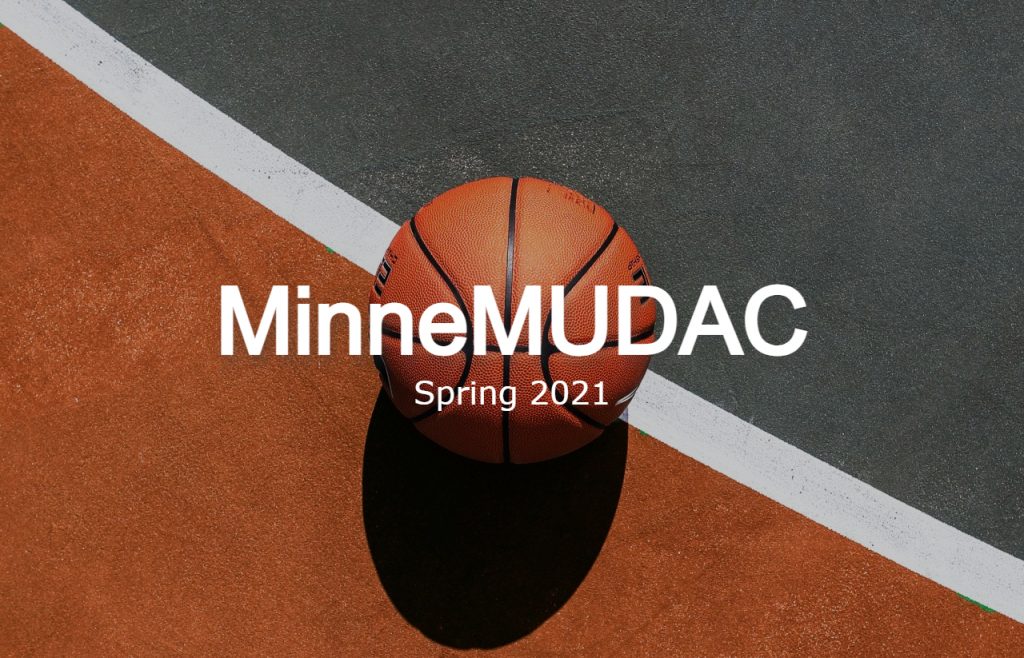Many of us look forward to the excitement of filling out March Madness brackets each year, but this year MinneAnalytics took that thrill to a new level. For the special Spring 2021 edition of the organization’s MinneMUDAC Student Data Science Challenge, student teams were invited to compete for bragging rights and cash prizes by building predictive models to make their picks. These machine-generated picks were also compared to a separate pool of human predictions to see how they would fare.
The results may not seem all that surprising: the predictive models created by students proved to be more successful at predicting the outcomes than their human competitors. Teams had two chances to make predictions – the main challenge began with the First Round of the NCAA Men’s Basketball Championship. A second “Sweet Sixteen” challenge was added once the championship was down to 16 teams. Student-led teams won both challenges decisively.
“I’m not saying you’ll be working for machines in the future,” said MinneAnalytics cofounder Dan Atkins. “I’m saying you’ll be working for some of these brilliant students that are creating these machines.”
The highest overall score in the main challenge was achieved by a team of undergraduates from the University of St. Thomas College of Arts and Sciences with a score of 171. They used a multivariate linear probability model with effective field goal percentage, turnover rate, and conference strength being their key independent variables. The team was comprised of Economics majors Mark Neuman and Patrick McLean, along with accounting major/economics minor Scott Kalthoff. Tyler Schipper, assistant professor in data analytics and economics, served as the teams faculty advisor.
An undergraduate team from the University of Minnesota – College of Science and Engineering took home first place in the Sweet Sixteen Challenge with a score of 116. Their methodology focused on picking upsets with seeding, 3 point percentage, and defensive efficiency as their key independent variables. Team members included Industrial and Systems Engineering (ISyE) students Sam Casey, Connor Fell, Isaac McCarney, and Will Titus, with faculty advisor Ankur Mani.
The top team among those in the graduate division was from University of Iowa, achieving a score of 145 in the main competition (4th place overall) and 112 in the Sweet Sixteen Challenge (2nd place overall). The team was comprised of student Tyler Dennis, who is pursuing an MS in Statistics, and faculty advisor Matt Bognar. According to Dennis, “we utilized a simple LDA model that used only information presented in an empty bracket, and the seasons from 2011-2012 through 2018-2019 were used to train the model.”
While the human pool overall was not as strong as the student machines, there were some standouts: Technovation[MN] executive director Lisa Schlosser, who has spoken at MinneAnalytics events in the past, came in second in the main challenge with an impressive score of 157. In the Sweet Sixteen Challenge, an 8th grader, Ray Anderson finished with a strong score of 104 (5th place overall).
MinneMUDAC is generally an annual challenge organized each fall, but last year the competition had to be called off due to pandemic concerns. The idea for a special spring challenge was brought to MinneAnalytics when Joe Lambrecht, a Computer Science and Data Analytics major at University of St. Thomas, contacted Dan Atkins.
“We were looking for fun ways to inspire students to explore data modeling and analysis outside of their coursework, and with March Madness just a month away, the timing was perfect,” said Lambrecht, who is the special programs director of the UST Data Science and Analytics Club. “Originally, we were looking at a school-wide competition, but I thought there was a lot of potential for the event beyond just one university.”
MinneMUDAC is presented by MinneAnalytics and the Midwest Undergraduate Data Analytics Competition (MUDAC). Thank you to all of the students, advisors, and professionals who took part in the competition. View the complete final standings at this link.

